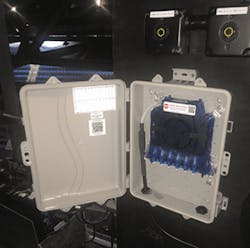Fiber-to-the-Tower Strategy for Right Now —
The wireless sector of the broadband market is beginning to experience some of the same growing pains that telecom companies had in the past with their landline business. The increasing need for quality broadband coverage, in addition to traditional voice services, is pushing providers to deploy more locations at an unprecedented pace. Along with this push is the additional need for more throughput, higher data rates, and, above all, network reliability. In addition, the skilled technician labor pool is diminishing but is critical to performing functions ranging from tower rigging, cable deployment, and terminations.
Commissioner Brendan Carr of the Federal Communications Commission stated in recent interviews that there are at least 20,000 available jobs for tower climbers to install equipment alone. Carr also said he has seen industry estimates that show upward of 100,000 5G wireless jobs being available. (Spoken in a March speech in Gulfport, MS, and again in an April speech at Aiken Technical College in Graniteville, SC.)
To attain the capacity needed for 5G and other technologies, fiber is needed at these locations, further exacerbating the technician shortfall. It has already been hard enough to get the needed tower techs, and yet now, providers need techs that can work with fiber in addition to the more traditional skill sets.
When it comes to fiber technicians, one of the most challenging work functions is fiber splicing. This is where using a Plug-and-Play approach can help alleviate those challenges by effectively avoiding the most difficult work functions, aka, splicing.
The early days of fusion splicing were expensive and clumsy. Thankfully, significant improvements in splicing techniques from manufacturers have been made. Today, splicing machines are more automated and easier to use. However, a skilled technician is still required to open the sheath, prep the fiber, cleave, and clean, before letting the machine do the easy part of the actual splice.
In the outside plant, an additional hurdle is the environmental conditions that must be endured while performing these tasks. Traditionally, telco splicers have had some sort of environmentally controlled enclosure to pull the fiber tails into before prepping the cable to splice. But, when you are a couple of hundred feet up on a tower structure, this daunting task leaves the door open for all sorts of splicing challenges. That is where Plug-and-Play product solutions provide some much-needed relief.
Still, in the world of wireless sites, the only options were either to have pre-connectorized cables manufactured to exact lengths, or built in the same footprint as the large coax cables that are traditionally used on towers. Two issues exist with these approaches: 1) the traditional approach is heavy, and 2) custom cables have very long lead times for delivery. Neither issue leads to faster deployments with fewer technicians.
Time Matters in the Real World
Early on, the MPO connector’s fragility and high insertion loss value kept it from being considered for use outside of the data center. There, runs are typically short compared to outside plant or on towers. The good news is that the concern with the insertion loss issue is improved by using advancements in connector manufacturing and quality control. Hardened connector housings were also developed to protect the connector from the harsh environment of the outside plant, thus resolving the fragility issue. However, one drawback of using these hardened connectors is that they are proprietary and shackle a provider to a single source for products.
With the advent of the pushable MPO coupled with microduct, a pushable MPO allows the wireless provider the ability to easily deploy fiber up the tower.
- A protective microduct routes up the tower, and a tech can simply drop the fiber cable equipped with an MPO connector down the duct.
- When it reaches its desired location, all the tech needs to do is remove the protective cover, snap the outer housing in place, and plug it into any MPO-capable termination.
- These multi-fiber (12f or 24f) MPOs can be put in service in minutes by a technician with little or no training.
InvisiLight® Solution for Deploying Fiber
April 2, 2022Go to Market Faster. Speed up Network Deployment
April 2, 2022Episode 10: Fiber Optic Closure Specs Explained…
April 1, 2022Food for Thought from Our 2022 ICT Visionaries
April 1, 2022Consider This Situation
A fixed wireless provider serving customers in eastern Canada struggled with Ethernet drops from the tower top to the bottom. The company needed to protect these cables from physical damage, lightning, noise, and ESD. Regardless of how carefully equipment was bonded and how advanced the ground field was, Ethernet ports at both ends of these links were common points of failure in electrical storms.
The team charged with solving this problem recognized the need to transition these connections to a fiber solution. However, they resisted moving to fiber because there were no solutions that met their need to be modular as well as Plug-and-Play. The need for Plug-and-Play capability stemmed from employing tower technicians not formally trained in fiber optics splicing or fiber management. Yet, these techs would be required to install and connect the electronics to a fiber link on the tower.
The solution, in this case, was provided by Clearfield’s pre-terminated MPO fiber cable and microduct. It included running a 14/10 microduct from an enclosure at the top of the tower equipped with an MPO capable breakout point to a 1RU MPO equipped panel in the base hut. This pathway allowed for the MPO cable assembly to be placed and terminated in just a few minutes, using the same techs that placed the microduct.
Additional smaller microducts (10/6) were then run from the breakout enclosures to each individual piece of equipment and connected with a smaller single fiber pre-terminated cable assembly. This equipment allowed technicians with no formal fiber training to just plug in the cables on each end and turn up the needed equipment. This eliminated much of the training time it would have required transitioning a tower rigger to a fiber technician.
Some additional benefits realized with this deployment method was a reduction of downstream troubleshooting. Because fiber is not prone to the same issues as copper, such as EMP interference and lightning strikes, and because the fiber is housed inside a ruggedized microduct, physical damage to the fiber is virtually eliminated.
Additionally, testing is also streamlined by eliminating all the various test meters required for testing copper links, and pared down to needing only a simple light source and power meter to perform the quick test for link integrity — saving both time and money.
Future wireless deployments will no doubt employ fiber as an integral part of the build. Providers can now begin to help evolve their technicians from being one-trick-techs to being fiber-friendly field experts using Plug-and-Play solutions. Because we all know — time matters.
For more information, email [email protected] or visit https://www.seeclearfield.com.
Follow Clearfield on Twitter @clearfieldfiber.
Follow Scot on Twitter @SBohaychyk.
Like this Article?
Subscribe to ISE magazine and start receiving your FREE monthly copy today!
About the Author
Scot Bohaychyk
Solutions Manager, Emtelle
Scot Bohaychyk is Solutions Manager for Emtelle in the US and Canada. He has more than 40 years of experience in communications solutions. Early in his career in telecoms, he was assigned to the White House Communications Agency, where he provided communications infrastructure support for President Ronald Reagan and his staff both in Washington and when travelling abroad. For more information, please email [email protected] or visit www.emtelle.com.
You can also follow Scot on Twitter: https://twitter.com/Sbohaychyk. Follow Emtelle on Twitter: https://twitter.com/EMTELLE, LinkedIn: https://www.linkedin.com/company/emtelle/, Facebook: https://www.facebook.com/Emtelle, and YouTube: https://www.youtube.com/user/Emtelle1.
Emtelle is opening a new facility in Fletcher, North Carolina, in 2023.






